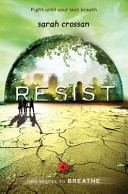2018 School Spending Survey Report
Resist
368p. HarperCollins/Greenwillow. 2013. Tr $17.99. ISBN 9780062118721; ebk. $8.79. ISBN 9780062118745. LC 2013011914.
COPY ISBN
In this sequel (and conclusion) to Breathe, the world is still perilously low on oxygen, and the have-nots are still slowly dying. Alina, Quinn, and Bea are still trying to save themselves--and perhaps the world if they can survive. Crossan effectively portrays hope as a feral, desperate thing that fuels the book's romances, betrayals, and alliances.
In this sequel (and conclusion) to Breathe (rev. 11/12), the world is still perilously low on oxygen, and the have-nots are still slowly dying. Alina, Quinn, and Bea, all of whose lives changed dramatically since Quinn and Bea were cast out of their protective dome dwellings, are still trying to save themselves--and perhaps the world if they can survive. This is a planet that is seriously in trouble, even more so now that the beautiful grove of trees, a symbol of a chance for recovery in the first volume, is gone. Crossan effectively portrays hope as a feral, desperate thing that keeps people fighting against oxygen depletion to remain alive and that fuels the book's romances, betrayals, alliances, and battles. The conclusion is tragic yet cathartic, a fitting end to a complex story set in a fraught world. april spisak
ALREADY A SUBSCRIBER? LOG IN
We are currently offering this content for free. Sign up now to activate your personal profile, where you can save articles for future viewing





Be the first reader to comment.
Comment Policy:
Comment should not be empty !!!